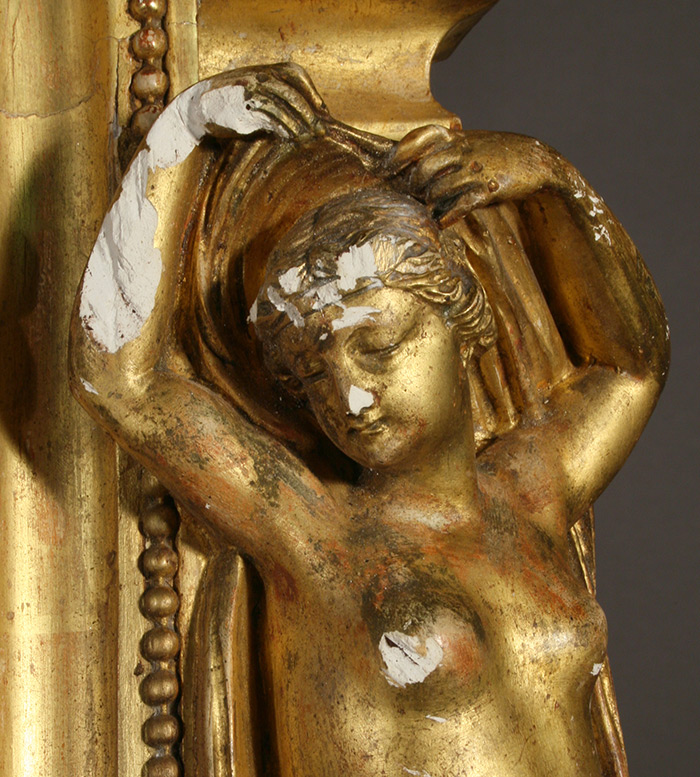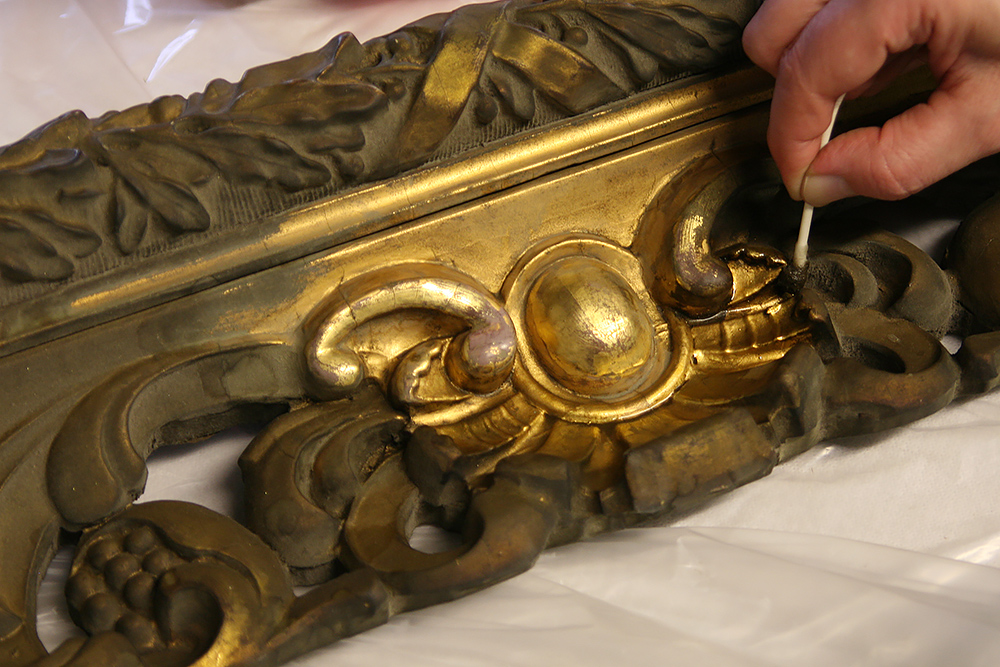Gold leaf is gently applied to areas of gilding loss
Gold leaf has been a revered surface decoration for thousands of years. Its color, reflectivity and permanence have been associated with beauty and richness in cultures and classes across the globe. There is something in the reflected light from this elemental material that triggers joy, awe, and fascination in the human consciousness as accessed through the eye.
Applying gold leaf requires expertise as well as an artist’s eye. It is a fragile, expensive and devilishly fickle material to work with. When applied with proper precision, the results can create a surface coating unmatched in its perfection. Bernacki & Associates Director of Conservation, Bart Bjornberg, is a Master Gilder with a Masters of Science in Historic Preservation 30 years experience in the field. Conservation & Design asked Bart to share his experiences with gold leaf.
What is the definition of gilding?
In its most basic definition, gilding can be described as the covering of a base or common material with a layer of gold. This layer is achieved through the application of gold leaf to an adhesive which has been applied to the surface to be gilded. It must be noted that there are other, lesser materials used to achieve a gilt surface. Composition leaf which is composed of copper and tin can be used. Just as well, bronze and mica powders mixed in a binder can make a ‘gold’ paint. These surfaces, while capable of being very attractive will never achieve the look of true gold leaf. They will also tarnish and discolor with age, never developing a patina.
The origins of gilding go back many years. Where was it used? Almost all of the world’s cultures have used gold. Tracing the chronology of gold’s use in art and culture reveals its broad appeal. While there are examples of gold foil wrapped objects which date from as early as 3000 BCE, the historical origins of gilding using gold leaf starts later. Egyptian tomb paintings and reliefs from the 23rd century BCE are the first known examples depicting gold being beaten into leaf.
Why is the process of applying gilding considered an “art”?
Gold pounded into leaf is a whisper thin sheet of paradox; properly applied it can transform a piece of ‘common’ material into what looks like solid, polished gold. It is ironically both delicate and strong. A sheet of gold leaf is so fragile that it is impossible to handle barehanded without it tearing and collapsing, practically into thin air. Gold leaf is so fine that it is incapable of supporting its own weight.
Despite the fragile nature of its form, the material itself is so chemically and metallurgically stable that it will not tarnish nor deteriorate as long as the substrate it lies on remains stable. That being said, on an unstable surface simply rubbing a soft, slightly moist cloth across an unsealed gilded surface can actually remove the gold.
You use two techniques in gold leafing. What are they?
Yes, there are two primary techniques used in gold leafing, oil gilding and water gilding. Oil gilding can provide a beautiful surface coating of matte gold. The process is quicker and less labor intensive than water gilding. In many situations it is as durable as water gilding and uses the same gold. Oil gilding must be applied to a completely sealed surface. First an oil size is applied to the surface. Sizes are now made of many different materials but most commonly are a boiled linseed oil. The applied oil is allowed to dry (oxidize) in a dust free environment until the proper tackiness is achieved. Then the gold leaf is applied.
A basic definition of water gilding would be a porous substrate (typically wood), covered with gesso (usually a mix of calcium carbonate and animal hide glue), covered with bole (a mixture of clay and animal or fish based glues), and covered with a layer of gold leaf held to the bole by organic animal or fish based glues. This golden surface can then be left matte or burnished to a mirror-like sheen. Water gilding is typically much more labor intensive than oil gilding but is also capable of achieving a more refined surface and sheen. Consequently it has been reserved for more expensive objects which are seen and experienced at more intimate distances.
On what objects do you typically apply gilding?
Gold leaf has been traditionally used on picture frames, mirror frames, furniture of all shapes and types, art objects (especially sculptural), ceramics, and architectural ornaments. Gilding can achieve the unmatched depth and reflection of a highly burnished glow or wonderfully varied patination of roughly distressed surface revealing the underlying clay. A gilded highlight can fully develop a sculptural detail or enliven a flat surface, as gold can offset natural dark browns and reds as well a brighter white, beige, or pastel shades.
Gold is truly a noble metal; adding importance to any object on which it is applied. Its application is limited only by the imaginations of the designer and the conservator preserving or newly designing a piece.
Gilt, or golden colored objects, can be beautiful and unique but also extremely fragile. They can last virtually forever or be damaged or destroyed in an instant. Totally impervious to light, chemicals, and time or wiped away with the briefest exposure to water. They are thoroughly understood by few and compromised by many.
Read full story...
Conservation and restoration often means trying to fix previous incompetent and inappropriate repairs. These are often much more difficult to repair than the original repairs would have been due to the introduction of incompatible coatings or adhesives that are very difficult to separate and remove from the original material. Sometimes you get lucky as we did recently with a gilded frame for a local client.
The carved wood frame came in completely covered with a bronze powder coating that seemed fairly recent though badly oxidized and was a dark green/brown. It was obvious that there were some losses of gesso on two of the corners but the rest of the carving seemed to be intact. Testing showed that the binder of the coating was nitrous- cellulose lacquer that broke down quickly with the introduction of lacquer thinner.
Read full story...
Two examples of chairs: both French, both from iconic periods and locations of French design and craftsmanship, both from a noted craftsman/designer and their workshops, both upholstered and gilt wood frame armchairs, both water gilded gold leaf, both with extensive gilding losses that were extremely visible, both damaged and needing treatment, both important enough to deserve conservation. The two examples of chairs are comparable in many ways but with completely different levels of problems.
One example is a set of two fauteuils from the second half of the eighteenth century. A fauteuil is style of armchair that has an upholstered seat, back, and armrests, has open arms, and has a primarily exposed wood frame that is often gilded. The set of chairs are stamped on the inside of the back seat rail: “I. GOVDRIN” (the V for a U).
Read full story...
Often furnishings, works of art, and decorative objects must be packed away and placed in storage. Much care must be taken in the proper handling, preparation, transportation and environment in which these valuable items will reside. The consideration of structural stability, surface fragility, and environmental parameters are key issues in the preservation of an object’s integrity. A basic understanding of an object’s construction materials and how these materials react to changes in climate, moisture, and time in storage is the first step in ensuring the preservation of a work of art.
Read full story...






